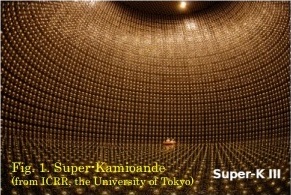Outline
Purpose of the Research Project
The main purposes of this project are: (1) to investigate unknown properties of “neutrinos”; (2) to establish a new picture of nature through neutrino research; (3) to approach the origin of elementary particles, the universe and the space-time.
(1) “Neutrino mass”, “neutrino mixing” and “difference between the neutrinos and antineutrinos” are still unknown. We aim to reveal the nature of neutrinos by experimental studies, observation of nature using neutrinos, and theoretical studies. (2) The universe is filled with neutrinos from different sources, such as the sun and supernovae. By observing these neutrinos, we establish a new picture of nature. (3) We develop new research of neutrinos toward big subjects: the origin of elementary particles, the universe and space-time.
Content of the Research Project
 This project will advance experiments to study the properties of neutrinos, observe neutrinos in nature, develop new technologies for particle physics experiments, and promote theoretical studies in neutrino field. We have the following research projects. (a) Measurement of neutrino oscillation using a neutrino beam from theJ-PARC accelerator to the Super-Kamiokande detector (Fig. 1). (b) Measurement of neutrino oscillation by observation of reactor neutrinos and further application of the techniques to reactor monitoring technology. (c) Observation of atmospheric neutrinos. R&D of the next generation nucleon-decay and neutrino detector “Hyper-Kamiokande” is promoted.(d) Investigation of deep space by observation of ultra-high-energy cosmic neutrinos. We will advance research and development of detectors based on new technologies: 3D imaging andultra-high spatial and energy resolutions. In theoretical studies, we will investigate theories to explain phenomena associated with neutrinos, nuclear structure and cosmology.
This project will advance experiments to study the properties of neutrinos, observe neutrinos in nature, develop new technologies for particle physics experiments, and promote theoretical studies in neutrino field. We have the following research projects. (a) Measurement of neutrino oscillation using a neutrino beam from theJ-PARC accelerator to the Super-Kamiokande detector (Fig. 1). (b) Measurement of neutrino oscillation by observation of reactor neutrinos and further application of the techniques to reactor monitoring technology. (c) Observation of atmospheric neutrinos. R&D of the next generation nucleon-decay and neutrino detector “Hyper-Kamiokande” is promoted.(d) Investigation of deep space by observation of ultra-high-energy cosmic neutrinos. We will advance research and development of detectors based on new technologies: 3D imaging andultra-high spatial and energy resolutions. In theoretical studies, we will investigate theories to explain phenomena associated with neutrinos, nuclear structure and cosmology.
Expected Research Achievements and Scientific Significance
We will provide the most precise measurement of neutrino oscillation parameters by accelerator and reactor neutrino experiments. The measurements will open the door to study the asymmetry of matter and antimatter in the neutrino sector. We aim to make the first observation of ultra-high-energy neutrinos by astrophysical neutrino experiment, and give a new picture of the universe. The development of advanced equipment for particle physics experiments will advance safeguard technologyfor nuclear reactors, promote the improvement of radiation imaging techniques, and influence the field of application. Theoretical studies focusing on neutrinos will make progress in a cross-sectional manner across particle physics, nuclear physics and astrophysics.
Combining all studies, we aim to address two fundamental mysteries, "How was the universe created?" and "What is space-time?".
Key Words
Neutrino: Neutrinos are elementary particles, similar to electrons but with no electric charge. There are three types of neutrinos. Non-zero neutrino mass was discovered by SuperKamiokande. Neutrinos change their types through a phenomenon called “neutrino oscillation”. Study of neutrino oscillations has advanced understanding nature of neutrinos.
